Reconstruction of Agriculture-Driven Deforestation in Western Hunan Province of China during the 18th Century
Abstract
:1. Introduction
2. Materials and Methods
2.1. Study Area
2.2. Data Sources
2.3. Reconstruction of the Deforestation in Western Hunan during the 18th Century
2.3.1. Reconstruction of the Spatial Pattern of the Settlement
2.3.2. Extraction of Land-Use Types
2.3.3. Estimation of the Maximum Agricultural Land Area around the Settlements
2.3.4. Reconstruction of the Spatiotemporal Pattern of Agricultural Land
2.3.5. Reconstruction of the Agriculture-Driven Deforestation
3. Results
3.1. Changes in the Distribution Pattern of Settlements
3.2. Agricultural Land Area and Forest Area Change
3.3. Changes in Land Use Pattern
4. Discussion
4.1. Assessment of the Agricultural Land Area Reconstruction
4.1.1. Assessment of the Results through the Description of Historical Documents
4.1.2. Assessment of the Results by Modern LUCC
4.1.3. Assessment of the Results Based on the Population Size
4.2. Comparisons with a Reconstruction Based on the Physical Environment without Settlements
4.3. Comparisons with Previous Studies
4.3.1. Comparison with the Previous LUCC Dataset
4.3.2. Comparison with Historical LUCC Reconstructions Based on Settlements
4.3.3. Comparison with Historical LUCC Reconstructed Using Sediment Evidence
4.4. Limitations and Prospects of This Study
5. Conclusions
Author Contributions
Funding
Institutional Review Board Statement
Informed Consent Statement
Data Availability Statement
Acknowledgments
Conflicts of Interest
Appendix A

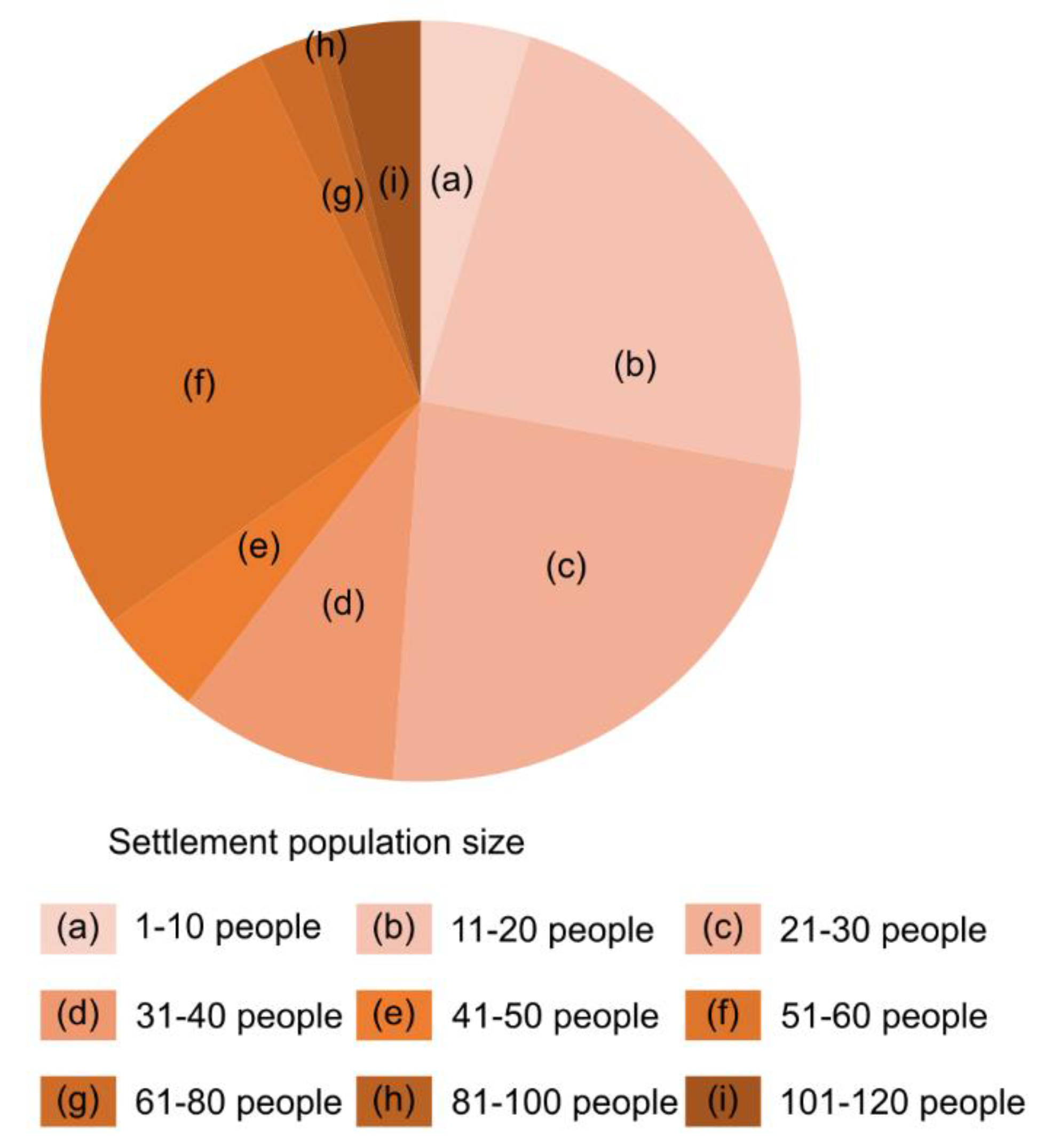

| 1 | Yongshun Fuzhi, Miaofang Beilan, Qianzhou Tingzhi, Chunan Miaozhi, Chenzhou Fuzhi, and Yongshun Xianzhi. |
References
- FAO. Global Forest Resources Assessment 2020: Main Report; United Nations: Rome, Italy, 2020.
- Erb, K.H.; Kastner, T.; Plutzar, C.; Bais, A.L.S.; Carvalhais, N.; Fetzel, T.; Gingrich, S.; Haberl, H.; Lauk, C.; Niedertscheider, M.; et al. Unexpectedly large impact of forest management and grazing on global vegetation biomass. Nature 2018, 553, 73–76. [Google Scholar] [CrossRef]
- Harris, N.L.; Gibbs, D.A.; Baccini, A.; Birdsey, R.A.; de Bruin, S.; Farina, M.; Fatoyinbo, L.; Hansen, M.C.; Herold, M.; Houghton, R.A.; et al. Global maps of twenty-first century forest carbon fluxes. Nat. Clim. Chang. 2021, 11, 234–240. [Google Scholar] [CrossRef]
- Aleman, J.C.; Jarzyna, M.A.; Staver, A.C. Forest extent and deforestation in tropical Africa since 1900. Nat. Ecol. Evol. 2018, 1, 26–33. [Google Scholar] [CrossRef]
- Tilman, D.; Clark, M.; Williams, D.R.; Kimmel, K.; Polasky, S.; Packer, C. Future threats to biodiversity and pathways to their prevention. Nature 2017, 546, 73–81. [Google Scholar] [CrossRef]
- Curtis, P.G.; Slay, C.M.; Harris, N.L.; Tyukavina, A.; Hansen, M.C. Classifying drivers of global forest loss. Science 2018, 361, 1108–1111. [Google Scholar] [CrossRef]
- Pendrill, F.; Persson, U.M.; Godar, J.; Kastner, T.; Moran, D.; Schmidt, S.; Wood, R. Agricultural and forestry trade drives large share of tropical deforestation emissions. Glob. Environ. Chang. 2019, 56, 1–10. [Google Scholar] [CrossRef]
- Mensing, S.; Schoolman, E.M.; Palli, J.; Piovesan, G. A consilience-driven approach to land use history in relation to reconstructing forest land use legacies. Landsc. Ecol. 2020, 35, 2645–2658. [Google Scholar] [CrossRef]
- Ellis, E.C.; Beusen, A.H.W.; Klein Goldewijk, K. Anthropogenic biomes: 10,000 BCE to 2015 CE. Land 2020, 5, 129. [Google Scholar] [CrossRef]
- Ellis, E.C.; Gauthier, N.; Klein Goldewijk, K.; Bliege Bird, R.; Boivin, N.; Díaz, S.; Fuller, D.Q.; Gill, J.L.; Kaplan, J.O.; Kingston, N.; et al. People have shaped most of terrestrial nature for at least 12,000 years. Proc. Natl. Acad. Sci. USA 2021, 118, e2023483118. [Google Scholar] [CrossRef] [PubMed]
- Kaplan, J.O.; Krumhardt, K.M.; Zimmermann, N. The prehistoric and preindustrial deforestation of Europe. Quat. Sci. Rev. 2009, 28, 3016–3034. [Google Scholar] [CrossRef]
- Zhou, W.; Huang, G.; Pickett, S.T.; Cadenasso, M.L. 90 years of forest cover change in an urbanizing watershed: Spatial and temporal dynamics. Landsc. Ecol. 2011, 26, 645–659. [Google Scholar] [CrossRef]
- Sudhakar Reddy, C.; Jha, C.S.; Dadhwal, V.K.; Krishna, P.H.; Pasha, S.V.; Satish, K.V.; Dutta, K.; Saranya, K.R.L.; Rakesh, F.; Rajashekar, G.; et al. Quantification and monitoring of deforestation in India over eight decades (1930–2013). Biodivers. Conserv. 2016, 25, 93–116. [Google Scholar] [CrossRef]
- Bucała-Hrabia, A. Long-term impact of socio-economic changes on agricultural land use in the Polish Carpathians. Land Use Policy 2017, 64, 391–404. [Google Scholar] [CrossRef]
- Yang, F.; He, F.N.; Li, M.J.; Li, S.C. Evaluating the reliability of global historical land use scenarios for forest data in China. J. Geogr. Sci. 2020, 30, 1083–1094. [Google Scholar] [CrossRef]
- Kaplan, J.O.; Krumhardt, K.M.; Ellis, E.C.; Ruddiman, W.F.; Lemmen, C.; Goldewijk, K.K. Holocene carbon emissions as a result of anthropogenic land cover change. Holocene 2011, 21, 775–791. [Google Scholar] [CrossRef] [Green Version]
- Klein Goldewijk, K.; Beusen, A.; Doelman, J.; Stehfest, E. Anthropogenic land use estimates for the Holocene—HYDE 3.2. Earth Syst. Sci. Data 2017, 9, 927–953. [Google Scholar] [CrossRef] [Green Version]
- Danneyrolles, V.; Dupuis, S.; Fortin, G.; Leroyer, M.; de Römer, A.; Terrail, R.; Vellend, M.; Boucher, Y.; Laflamme, J.; Bergeron, Y. Stronger influence of anthropogenic disturbance than climate change on century-scale compositional changes in northern forests. Nat. Commun. 2019, 10, 1265. [Google Scholar] [CrossRef]
- Gaillard, M.J.; Morrison, K.D.; Madella, M.; Whitehouse, N. Past land-use and land-cover change: The challenge of quantification at the subcontinental to global scales. Pages Mag. 2018, 26, 3. [Google Scholar]
- Morrison, K.D.; Hammer, E.; Boles, O.; Madella, M.; Whitehouse, N.; Gaillard, M.-J.; Bates, J.; Linden, M.V.; Merlo, S.; Yao, A.; et al. Mapping past human land use using archaeological data: A new classification for global land use synthesis and data harmonization. PLoS ONE 2021, 16, e0246662. [Google Scholar] [CrossRef]
- Yu, Z.; Jin, X.B.; Miao, L.J.; Yang, X.H. A historical reconstruction of cropland in China from 1900 to 2016. Earth Syst. Sci. Data 2021, 13, 3203–3218. [Google Scholar] [CrossRef]
- Kaplan, J.O.; Krumhardt, K.; Gaillard, M.-J.; Sugita, S.; Trondman, A.-K.; Fyfe, R.; Marquer, L.; Mazier, F.; Nielsen, A. Constraining the deforestation history of Europe: Evaluation of historical land use scenarios with pollen-based land cover reconstructions. Land 2017, 6, 91. [Google Scholar] [CrossRef] [Green Version]
- Weiberg, E.; Hughes, R.E.; Finné, M.; Bonnier, A.; Kaplan, J.O. Mediterranean land use systems from prehistory to antiquity: A case study from Peloponnese (Greece). J. Land Use Sci. 2019, 14, 1–20. [Google Scholar] [CrossRef] [Green Version]
- Harrison, S.P.; Gaillard, M.J.; Stocker, B.D.; Vander Linden, M.; Klein Goldewijk, K.; Boles, O.; Braconnot, P.; Dawson, A.; Fluet-Chouinard, E.; Kaplan, J.O.; et al. Development and testing scenarios for implementing land use and land cover changes during the Holocene in earth system model experiments. Geosci. Model Dev. 2020, 13, 805–824. [Google Scholar] [CrossRef] [Green Version]
- Yu, Y.Y.; Wu, H.B.; Finke, P.A.; Guo, Z.T. Spatial and temporal changes of prehistoric human land use in the Wei River valley, northern China. Holocene 2016, 26, 1788–1801. [Google Scholar] [CrossRef]
- Wu, Z.L.; Fang, X.Q.; Jia, D.; Zhao, W.Y. Reconstruction of cropland cover using historical literature and settlement relics in farming areas of Shangjing Dao during the Liao Dynasty, China, around 1100 AD. Holocene 2020, 11, 1516–1527. [Google Scholar] [CrossRef]
- Huo, R.L.; Yang, Y.D.; Man, Z.M. Gridded reconstruction of spatiotemporal evolution of cropland in the Zhangjiu River Basin in Yunnan Province from 1700 to 1978. Acta Geogr. Sin. 2020, 9, 1966–1982, (In Chinese with English Abstract). [Google Scholar]
- Ning, J.; Liu, J.Y.; Kuang, W.H.; Xu, X.L.; Zhang, S.W.; Yan, C.Z.; Li, R.D.; Wu, S.X.; Hu, Y.F.; Du, G.M.; et al. Spatiotemporal patterns and characteristics of land-use change in China during 2010–2015. J. Geogr. Sci. 2018, 28, 547–562. [Google Scholar] [CrossRef] [Green Version]
- Liu, M.; Tian, H. China’s land cover and land use change from 1700 to 2005: Estimations from high-resolution satellite data and historical archives. Glob. Biogeochem. Cycles 2010, 24, GB3003. [Google Scholar] [CrossRef]
- Zou, Y.L.; Zhang, X.G.; Wang, S.C. The Physical Geography in Chinese History; Science Press: Beijing, China, 2013. (In Chinese) [Google Scholar]
- Wang, W.; Li, C.; Shu, J.; Chen, W. Changes of vegetation in southern China. Sci. China Earth Sci. 2019, 62, 1316–1328. [Google Scholar] [CrossRef]
- Zhang, Y.; Marquer, L.; Cui, Q.; Zheng, Z.; Zhao, Y.; Wan, Q.; Zhou, A. Holocene vegetation changes in the transition zone between subtropical and temperate ecosystems in Eastern Central China. Quat. Sci. Rev. 2021, 253, 106768. [Google Scholar] [CrossRef]
- Marks, R.B. China: Its Environment and History; Rowman & Littlefield Publishers: Lanham, MD, USA, 2011. [Google Scholar]
- Han, M.L. Chinese Historical Agricultural Geography; Peking University Press: Beijing, China, 2012. (In Chinese) [Google Scholar]
- Braun, A.; Rosner, H.J.; Hagensieker, R.; Dieball, S. Multi-method dynamical reconstruction of the ecological impact of copper mining on Chinese historical landscapes. Ecol. Model. 2015, 303, 42–54. [Google Scholar] [CrossRef]
- Wang, L.H. The gap between thought and action: An overview of the thought on natural resources and environmental protection in ancient China. Hist. Bimon. 2020, 2, 74–86, (In Chinese with English Abstract). [Google Scholar]
- He, F.N.; Ge, Q.S.; Dai, J.H. Quantitative analysis on forest dynamics of China in recent 300 years. Acta Geogr. Sin. 2017, 62, 30–40. (In Chinese) [Google Scholar]
- Wu, D.; Zhou, A.; Liu, J.; Chen, X.; Wei, H.; Sun, H.; Yu, J.; Bloemendal, J.; Chen, F. Changing intensity of human activity over the last 2000 years recorded by the magnetic characteristics of sediments from Xingyun Lake, Yunnan, China. J. Paleolimnol. 2015, 53, 47–60. [Google Scholar] [CrossRef]
- Yang, W.B. Land use and ecological change in Yunnan-Guizhou Plateau; Shanghai People’s Publishing House: Shanghai, China, 2008. (In Chinese) [Google Scholar]
- Zhang, L.S.; Fang, X.Q. Paleogeography of China: The Formation of China’s Natural Environment; Science Press: Beijing, China, 2012. (In Chinese) [Google Scholar]
- Chen, J.; Chen, J.; Liao, A.; Cao, X.; Chen, L.; Chen, X.; He, C.; Han, G.; Peng, S.; Lu, M.; et al. Global land cover mapping at 30 m resolution: A POK-based operational approach. ISPRS J. Photogramm. Remote Sens. 2014, 103, 7–27. [Google Scholar] [CrossRef] [Green Version]
- Morrison, K.D.; Tello, E.; Hammer, E.; Popova, L.; Madella, M.; Whitehouse, N.; Gaillard, M.J. Global-scale comparisons of human land use: Developing shared terminology for land-use practices for global change. Pages Mag. 2018, 26, 8–9. [Google Scholar]
- Kay, A.U.; Kaplan, J.O. Human subsistence and land use in Sub-Saharan Africa, 1000 BC to AD 1500: A review, quantification and classification. Anthropocene 2015, 9, 14–32. [Google Scholar] [CrossRef]
- Hughes, R.E.; Weiberg, E.; Bonnier, A.; Finné, M.; Kaplan, J.O. Quantifying land use in past societies from cultural practice and Archaeological Data. Land 2018, 7, 9. [Google Scholar] [CrossRef] [Green Version]
- Luo, Y.S. The Socio-Economic Development of the Yuanshui River Basin during the Ming and Qing Dynasties; Social Science Literature Press: Beijing, China, 2016. (In Chinese) [Google Scholar]
- Yin, S.T. Disappearing Wildfire: Slash and Burn Cultivation in Anthropological Perspective; Yunnan People’s Publishing House: Kunming, China, 2008. (In Chinese) [Google Scholar]
- Tan, B.Y. The Modern Reconstruction of Hunan Miaojiang Multi-National Community in the Qing Dynasty; Nationalities Press: Beijing, China, 2009. (In Chinese) [Google Scholar]
- Li, F.; Gaillard, M.-J.; Cao, X.; Herzschuh, U.; Sugita, S.; Tarasov, P.E.; Wagner, M.; Xu, Q.; Ni, J.; Wang, W.; et al. Towards quantification of Holocene anthropogenic land-cover change in temperate China: A review in the light of pollen-based REVEALS reconstructions of regional plant cover. Earth Sci. Rev. 2020, 203, 103119. [Google Scholar] [CrossRef]
- Lan, Y. Vegetation succession of the medium and low mountainous areas along the subtropics of the upper Yangtze River in recent 500 years. Geogr. Res. 2010, 29, 1182–1192. (In Chinese) [Google Scholar]
- Shi, Z.H. Agricultural Development in Qing China: A Quantitative Study, 1661-1911; Social Science Literature Press: Beijing, China, 2017. (In Chinese) [Google Scholar]
- Klein Goldewijk, K.; Dekker, S.C.; van Zanden, J.L. Per-capita estimations of long-term historical land use and the consequences for global change research. J. Land Use Sci. 2017, 12, 313–337. [Google Scholar] [CrossRef] [Green Version]
- Cao, S.J. Chinese Population History; Fudan University Press: Shanghai, China, 2005. (In Chinese) [Google Scholar]
- Kuo, T.S.; Liu, Z.Q.; Li, H.C.; Wan, N.J.; Shen, C.C.; Ku, T.L. Climate and environmental changes during the past millennium in central western Guizhou, China as recorded by Stalagmite ZJD-21. J. Asian Earth Sci. 2011, 40, 1111–1120. [Google Scholar] [CrossRef]
- Xiao, X.; Haberle, S.G.; Shen, J.; Yang, X.; Han, Y.; Zhang, E.; Wang, S. Latest Pleistocene and Holocene vegetation and climate history inferred from an alpine lacustrine record, northwestern Yunnan Province, southwestern China. Quat. Sci. Rev. 2014, 86, 35–48. [Google Scholar] [CrossRef]
- Yu, X.S.; Meng, H.W.; Huang, P.L.; Sun, Q.F.; Wang, M.; Zhang, H.C.; Shen, C.M. Environmental changes over the past 1200 years in the catchment of Yangzonghai Lake, Central Yunnan. Chin. J. Ecol. 2020, 39, 1896–1910, (In Chinese with English Abstract). [Google Scholar]
- He, F.N.; Li, S.C.; Zhang, X.Z. A spatially explicit reconstruction of forest cover in China over 1700–2000. Glob. Planet. Chang. 2015, 131, 73–81. [Google Scholar] [CrossRef]
- Li, S.C.; He, F.N.; Zhang, X.Z. A spatially explicit reconstruction of cropland cover in China from 1661 to 1996. Reg. Environ. Chang. 2016, 16, 417–428. [Google Scholar] [CrossRef] [Green Version]
- Yang, X.; Jin, X.; Du, X.; Xiang, X.; Han, J.; Shan, W.; Fan, Y.; Zhou, Y. Multi-agent model-based historical cropland spatial pattern reconstruction for 1661–1952, Shandong Province, China. Glob. Planet. Chang. 2016, 143, 175–188. [Google Scholar] [CrossRef] [Green Version]
- Yang, X.H.; Jin, X.B.; Xiang, X.M.; Fan, Y.T.; Shan, W.; Zhou, Y.K. Reconstructing the spatial pattern of historical forest land in China in the past 300 years. Glob. Planet. Chang. 2018, 165, 173–185. [Google Scholar] [CrossRef] [Green Version]
- Wang, Q.; Xiong, M.; Li, Q.; Li, H.; Lan, T.; Deng, O.; Huang, R.; Zeng, M.; Gao, X. Spatially explicit reconstruction of cropland using the random forest: A case study of the Tuojiang River Basin, China from 1911 to 2010. Land 2021, 10, 1338. [Google Scholar] [CrossRef]
- Zheng, J.Y.; Ge, Q.S.; Hao, Z.H.; Liu, H.L.; Man, Z.M.; Hou, Y.J.; Fang, X.Q. Paleoclimatology proxy recorded in historical documents and method for reconstruction on climate change. Quat. Sci. 2014, 6, 1186–1196, (In Chinese with English Abstract). [Google Scholar]

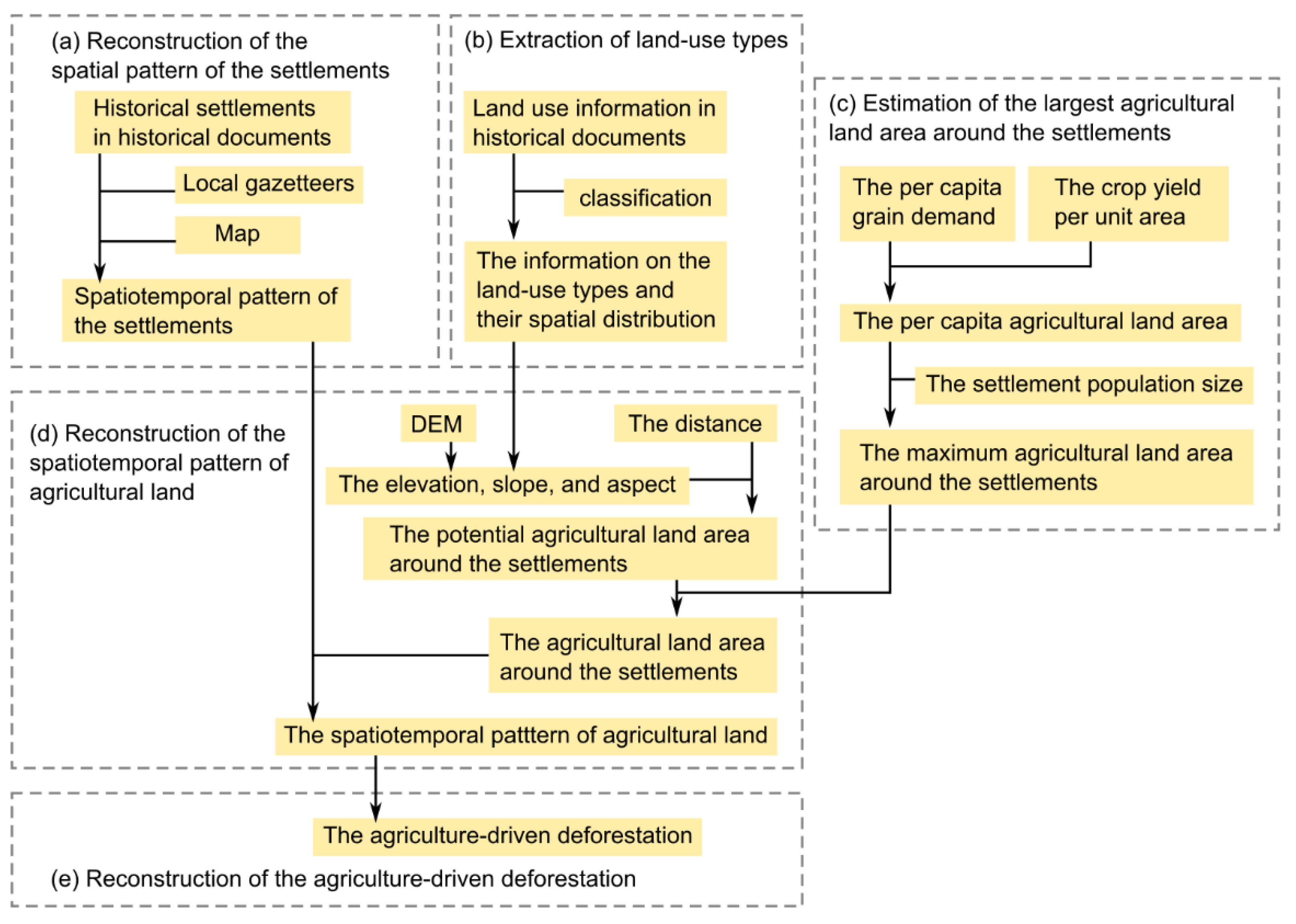

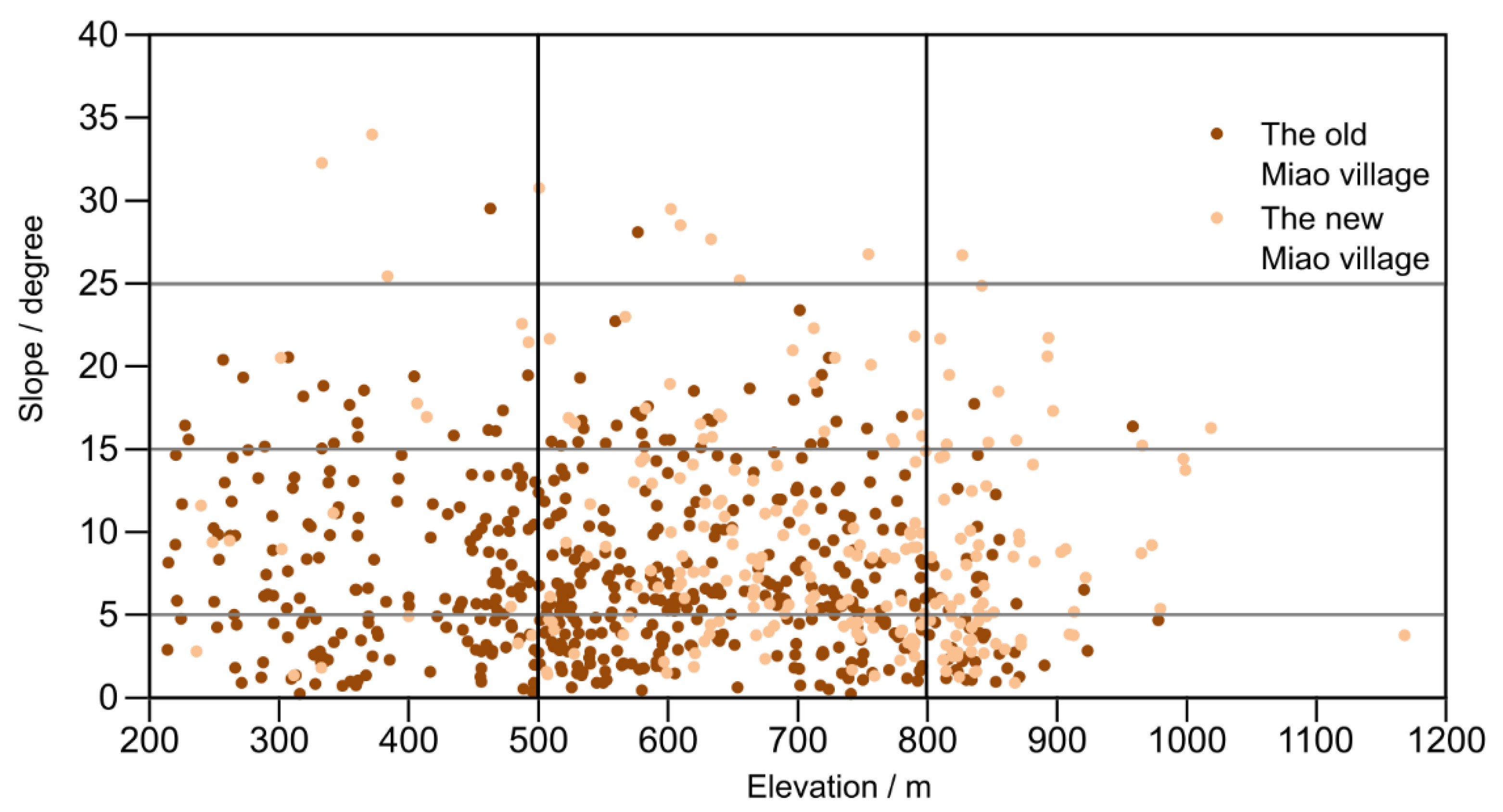
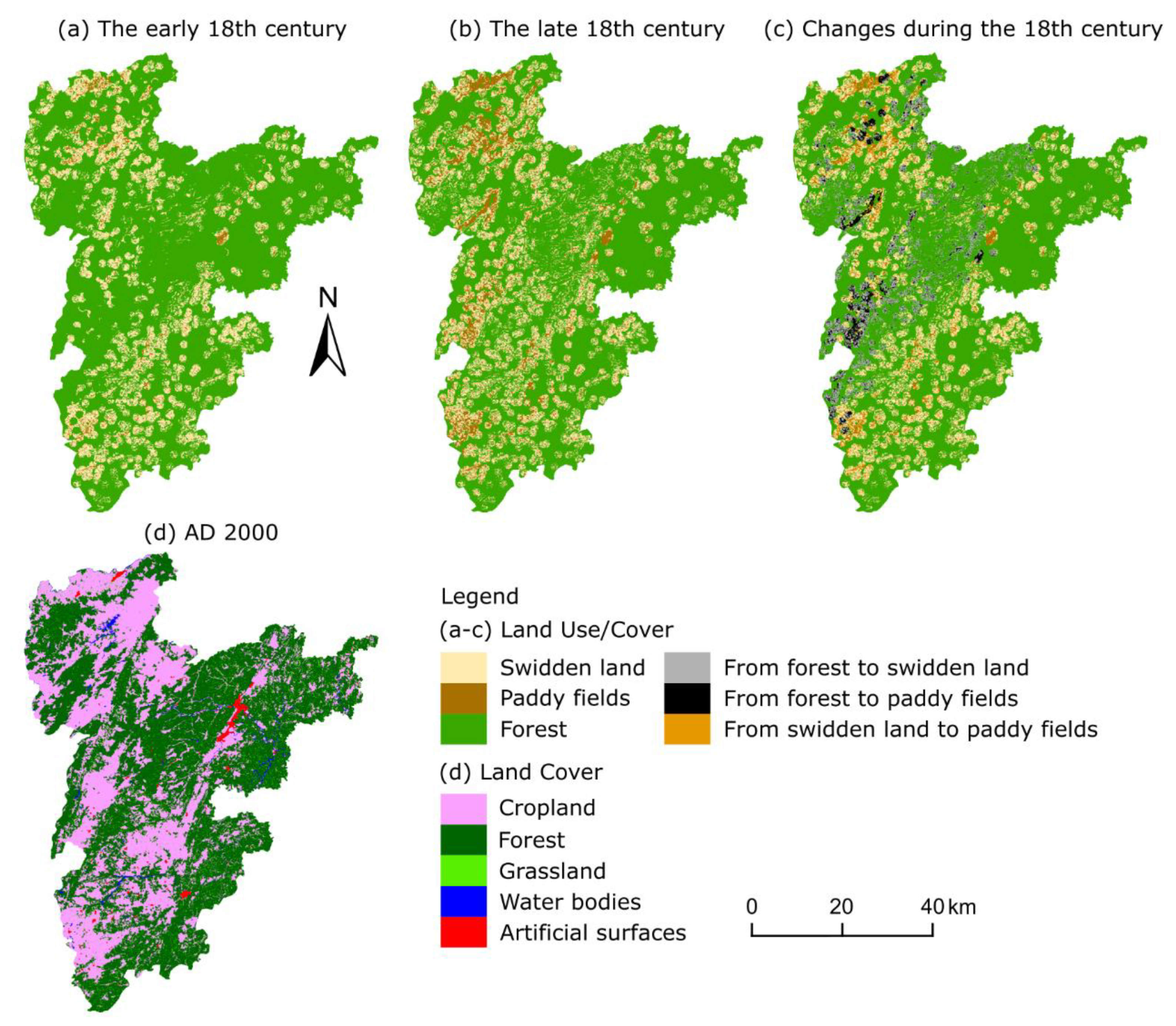
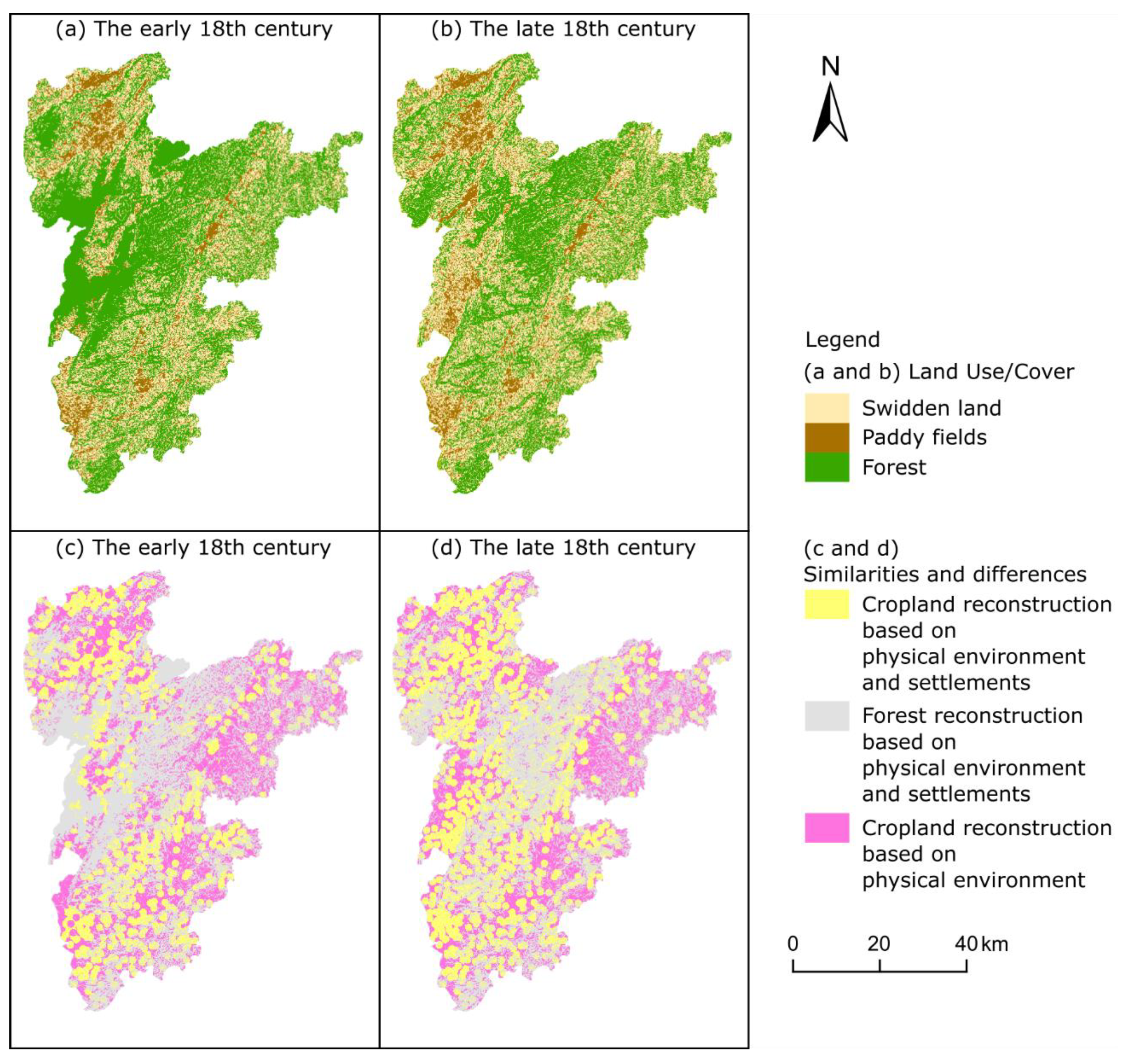

| Data Sources | Data Types |
|---|---|
| Historical documents | Local gazetteers of the Qing Dynasty |
| Other historical documents | |
| Modern survey and collation materials | Modern local gazetteers |
| Materials of the agricultural regionalization | |
| Modern toponymic gazetteers | |
| Terrain information | Digital Elevation Model |
| Land Use Types | Spatial Distribution | Record Examples in Historical Documents | Source a |
|---|---|---|---|
| Rice paddy | Valley | People plant the rice in a place with gentle terrain that is easy to irrigate. | YSFZ |
| People plant the rice in the river valley. | MFBL | ||
| There is a small amount of cropland in the mountain valley. | QZTZ | ||
| People plant the rice in a place with gentle terrain. | CNMZ | ||
| The Miao people tend to cultivate on sunny slopes. | CNMZ | ||
| Shifting cultivation | Hillside with less steep slopes | The Miao people grow crops using the slash and burn method in the mountainous areas. | CNMZ |
| People burn the weeds and plant the crops on hillsides. | MFBL | ||
| People carry out slash and burn farming on relatively gentle hillsides. | CNMZ | ||
| People have to open up forestland for farming in the mountainous areas at higher elevations and on steeper slopes when the gentle land has been reclaimed. | CNMZ | ||
| Agroforestry | Hillside | People plant Tung trees along the mountain ridge. | CZFZ |
| People plant the dryland crops on the mountainside with a gentle slope, but they plant Tung trees on the mountain with a steeper slope. | YSFZ | ||
| Hunting-foraging | Hillside | People go to the mountains to pick ferns and pueraria and eat them when their food crops failed. | YSXZ |
| People choose to cut trees, fish, and hunt in winter. | CZFZ | ||
| Pastoralism | Hillside | People graze cattle on the mountain and keep horses near the house from mid-spring to mid-autumn, and they graze cattle and horses on the mountain after the eighth month of the lunar calendar. | CNMZ |
Publisher’s Note: MDPI stays neutral with regard to jurisdictional claims in published maps and institutional affiliations. |
© 2022 by the authors. Licensee MDPI, Basel, Switzerland. This article is an open access article distributed under the terms and conditions of the Creative Commons Attribution (CC BY) license (https://creativecommons.org/licenses/by/4.0/).
Share and Cite
Li, Y.; Ye, Y.; Fang, X.; Liu, Y. Reconstruction of Agriculture-Driven Deforestation in Western Hunan Province of China during the 18th Century. Land 2022, 11, 181. https://doi.org/10.3390/land11020181
Li Y, Ye Y, Fang X, Liu Y. Reconstruction of Agriculture-Driven Deforestation in Western Hunan Province of China during the 18th Century. Land. 2022; 11(2):181. https://doi.org/10.3390/land11020181
Chicago/Turabian StyleLi, Yikai, Yu Ye, Xiuqi Fang, and Yachen Liu. 2022. "Reconstruction of Agriculture-Driven Deforestation in Western Hunan Province of China during the 18th Century" Land 11, no. 2: 181. https://doi.org/10.3390/land11020181
APA StyleLi, Y., Ye, Y., Fang, X., & Liu, Y. (2022). Reconstruction of Agriculture-Driven Deforestation in Western Hunan Province of China during the 18th Century. Land, 11(2), 181. https://doi.org/10.3390/land11020181







